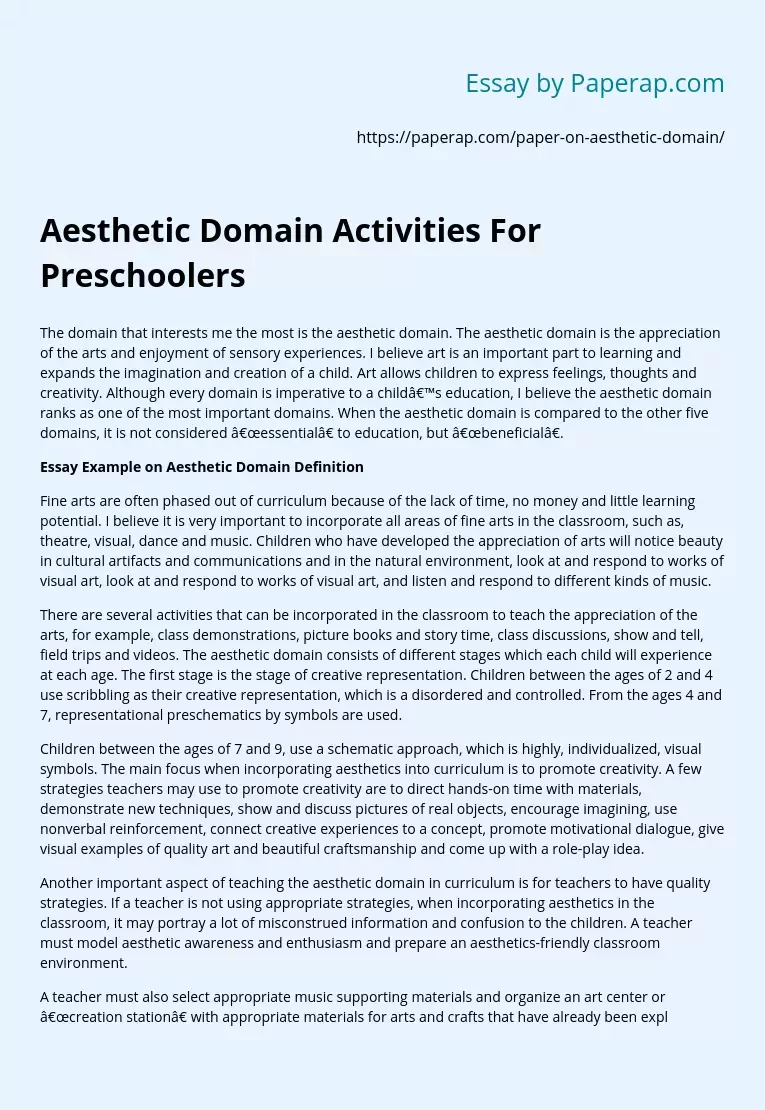Aesthetic Domain Activities For Preschoolers
The domain that interests me the most is the aesthetic domain. The aesthetic domain is the appreciation of the arts and enjoyment of sensory experiences. I believe art is an important part to learning and expands the imagination and creation of a child. Art allows children to express feelings, thoughts and creativity. Although every domain is imperative to a child’s education, I believe the aesthetic domain ranks as one of the most important domains. When the aesthetic domain is compared to the other five domains, it is not considered “essential” to education, but “beneficial”.
Essay Example on Aesthetic Domain Definition
Fine arts are often phased out of curriculum because of the lack of time, no money and little learning potential. I believe it is very important to incorporate all areas of fine arts in the classroom, such as, theatre, visual, dance and music. Children who have developed the appreciation of arts will notice beauty in cultural artifacts and communications and in the natural environment, look at and respond to works of visual art, look at and respond to works of visual art, and listen and respond to different kinds of music.
There are several activities that can be incorporated in the classroom to teach the appreciation of the arts, for example, class demonstrations, picture books and story time, class discussions, show and tell, field trips and videos. The aesthetic domain consists of different stages which each child will experience at each age. The first stage is the stage of creative representation.
Children between the ages of 2 and 4 use scribbling as their creative representation, which is a disordered and controlled. From the ages 4 and 7, representational preschematics by symbols are used.
Children between the ages of 7 and 9, use a schematic approach, which is highly, individualized, visual symbols. The main focus when incorporating aesthetics into curriculum is to promote creativity. A few strategies teachers may use to promote creativity are to direct hands-on time with materials, demonstrate new techniques, show and discuss pictures of real objects, encourage imagining, use nonverbal reinforcement, connect creative experiences to a concept, promote motivational dialogue, give visual examples of quality art and beautiful craftsmanship and come up with a role-play idea.
Another important aspect of teaching the aesthetic domain in curriculum is for teachers to have quality strategies. If a teacher is not using appropriate strategies, when incorporating aesthetics in the classroom, it may portray a lot of misconstrued information and confusion to the children. A teacher must model aesthetic awareness and enthusiasm and prepare an aesthetics-friendly classroom environment.
A teacher must also select appropriate music supporting materials and organize an art center or “creation station” with appropriate materials for arts and crafts that have already been explored by the teacher before asking the children to use them. Providing a variety of creative movement props and props for dramatics is also an important strategy. More strategies include teaching children to respect and care for materials, motivating creativity through a variety of strategies and valuing all aspects of the creative expression process.
A teacher should avoid making a product when demonstrating a technique to the class and begin each movement experience with a similar routine warm-up and end with a similar cool down. Most importantly, a teacher should accept children’s own ideas for creative movement, use questions to describe, analyze and evaluate art, avoid reinforcing only a realistic approach and to involve all of the children in the arts. There are several projects and activities a teacher can incorporate in the curriculum to encourage the children to express the aesthetic domain.
Teachers can use songs to teach literacy or having the children create songs about a topic. Children may also be encouraged to use musical instruments. Teac hers may also use poems, puppets and fingerplays, as well as listening to taped stories or guest speakers. Children can have their own book making experience or create paintings or other arts and crafts as well. The aesthetic domain is detrimental to the education of our young people and can bring out many different educational skills of a child once they are allowed to freely express and explore themselves.
Resources
href=”http://www.songsforteaching.com/teachertips.htm” data-wpel-link=”external” rel=”nofollow”>http://www.songsforteaching.com/teachertips.htm
Aesthetic Domain Activities For Preschoolers. (2019, Nov 27). Retrieved from https://paperap.com/paper-on-aesthetic-domain/

